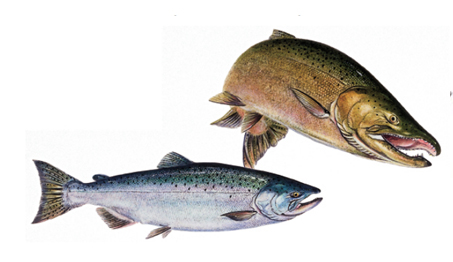Common Names: Chinook salmon, king salmon, tyee, Chinook
Habitat
The Chinook was introduced into the Great Lakes from the Pacific Coast in as early as 1867. Major stocking efforts in the 1960s by Michigan state were undertaken to control invading alewife populations and resulted in large spawning runs in the 1970s. Chinooks are currently found in all the Great Lakes, and spawning populations have been reported in all of them except Lake Erie. Most of the chinook’s life is spent in the main basin of the lake and it only returns to tributaries to spawn.
Spawning Patterns
Chinooks spawn only once in their lifetime and die almost immediately after spawning. In Great Lakes populations spawning occurs mainly in the fall, although Lake Superior has at least one tributary with a spring run. The spawning run lasts from late August to mid-October. Most fish mature and return to spawn between the ages of three to five, but fish may be as young as two, or as old as nine. The female guards the redd until she dies which is usually only a week after spawning.
Diet
Adult chinooks feed exclusively on other fish species (piscivorous). The major species in the diet are smelt and alewife. Juveniles feed on plankton, aquatic insects and small fish.
Age and Size
Lake Superior has the slowest growing chinooks of the Great Lakes, but growth rates are extremely fast compared to other fish in Ontario. Considering the average life expectancy of a chinook salmon is only about four or five years, it is amazing that these fish can reach weights in excess of 40 lbs! Pacific coast fish show even greater rates of growth, reaching weights greater than 100 lbs.
Fishing Tips
Trolling throughout the summer months with spoons or plugs are proven techniques. Because Chinooks feed on large schools of alewife and smelt, they tend to be concentrated and migratory. Locating them on a regular basis may be difficult, but with the help of a charter service, your chances definitely increase. During spawning time, chinooks concentrate around larger rivers. Fish that have just recently moved into the rivers provide a better fight and are of better eating quality as the flesh deteriorates the closer it gets to the actual spawning event. Roe bags fished either under a float or on bottom are popular among river anglers.
Fish illustration ©CURTIS ATWATER (www.natureartists.com/atwaterc.htm)









